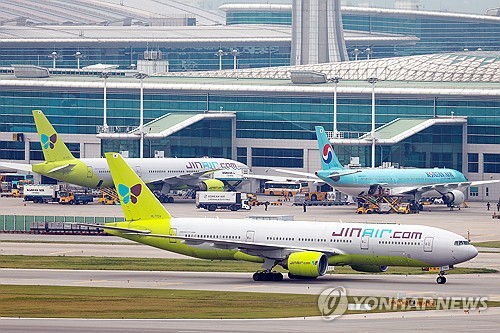

(Seoul=Yonhap Infomax) Jong Hwa Han – The US dollar–South Korean won exchange rate has remained in the 1,470-won range, a level last seen during the 2008 financial crisis, putting the country’s airline industry—highly sensitive to currency fluctuations—at risk of significant losses.
Even Korean Air Lines Co., the nation’s largest carrier, is expected to incur valuation losses in the hundreds of billions of won, as the entire sector faces a direct hit from the surging exchange rate.
According to the Financial Supervisory Service’s electronic disclosure system on the 26th, Korean Air disclosed in its third-quarter report that a 10-won rise in the dollar-won rate would result in a 48 billion won ($36.7 million) foreign currency valuation loss on its net foreign currency debt position.
In terms of cash flow, Korean Air’s annual dollar shortfall stands at $1.6 billion (2.3456 trillion won), meaning every 10-won fluctuation in the exchange rate shakes its cash flow by 1.6 billion won ($1.2 million).
Given that the dollar-won rate has climbed more than 100 won from last year’s average of 1,366.63 to the current 1,470 range, Korean Air’s valuation losses could potentially balloon into the trillions of won.
In the third quarter, Korean Air posted a foreign exchange translation loss of 175.2 billion won ($134 million), partially offset by gains from derivatives.
However, foreign currency valuation losses are accounting losses, allowing some time for recovery if the exchange rate falls before losses are realized.
In contrast, the increase in operating costs due to the stronger dollar immediately erodes Korean Air’s earnings.
NH Investment & Securities projects Korean Air’s standalone operating margin will fall from 11.8% last year to 9.3% this year, as costs sensitive to the exchange rate—including airport fees, depreciation, and fuel expenses—rise across the board. Typically, over 50% of airline costs are exposed to the US dollar.
“A large portion of airline operating costs—such as fuel, maintenance, and airport-related expenses—are dollar-denominated,” said Do Hyun Ahn, analyst at Hana Securities. “With the high exchange rate persisting, cost pressures will only increase.”
Although global jet fuel prices have declined this year, the effect has been largely offset by the stronger dollar. The average jet fuel price fell from $95.3 per barrel last year to $86 this year, a 9.5% drop, but the 7–8% rise in the exchange rate has nearly nullified the benefit.
The stronger dollar not only directly increases costs but also dampens demand for overseas travel, delivering a double or even triple blow to airlines’ revenues, costs, and net foreign currency debt positions.
Korean Air, as the industry leader, can withstand the impact with reduced operating profit. However, low-cost carriers (LCCs) with weaker financials are suffering deeper losses. In the third quarter, Jeju Air Co. posted a 55 billion won ($42 million) loss, while T’way Air Co. recorded a 95.5 billion won ($73 million) loss, both pressured by the strong dollar and oversupply.
Jin Air Co., a Korean Air affiliate, and Air Busan Co. reported losses of 22.5 billion won ($17 million) and 28.5 billion won ($22 million), respectively.
An airline industry official said, “The dollar-won exchange rate is lingering in an unexpected range compared to past cases. The unprecedented level of the exchange rate has thrown the industry into chaos.”
jhhan@yna.co.kr
(End)
Copyright © Yonhap Infomax Unauthorized reproduction and redistribution prohibited.

